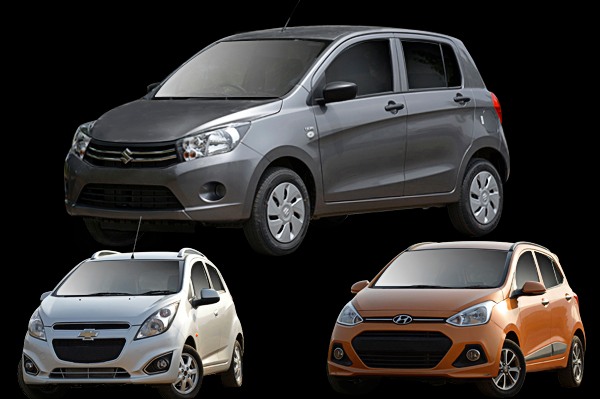A look at how each car compares on paper.
 The Celerio may have started the AMT uprising in India, but the new diesel model of the car is a pioneer for a whole other reason. It is the launch vehicle for Suzuki and Maruti’s first ground-up diesel engine. For customers, however, the most vital fact here is its ARAI-tested fuel economy of 27.62kpl that makes it the most fuel-efficient car in the country. The Beat diesel held that position earlier and will be among the Celerio’s chief rivals. Another option is the Hyundai Grand i10 diesel, which again has good fuel economy and shrewd pricing on its side. We compare these three cars to see how they match spec-to-spec.
The Celerio may have started the AMT uprising in India, but the new diesel model of the car is a pioneer for a whole other reason. It is the launch vehicle for Suzuki and Maruti’s first ground-up diesel engine. For customers, however, the most vital fact here is its ARAI-tested fuel economy of 27.62kpl that makes it the most fuel-efficient car in the country. The Beat diesel held that position earlier and will be among the Celerio’s chief rivals. Another option is the Hyundai Grand i10 diesel, which again has good fuel economy and shrewd pricing on its side. We compare these three cars to see how they match spec-to-spec.
Under the hood
On paper, the Celerio diesel is at a disadvantage due to its small 793cc, two-cylinder engine. Power and torque are also on the lower side here with figures of just 47bhp and 12.7kgm, respectively. The Beat diesel, on the other hand, is the second most-powerful car here with its three-cylinder, 1.0-litre making 56bhp and 15.3kgm. The Hyundai has the upper hand on this front. Its 1.1-litre, three-cylinder diesel engine is the largest here and also delivers the highest figures — 70bhp of power and 16.29kgm of torque. But what’s also imperative is that the Grand i10 is the heaviest of the cars being compared here, weighing a relatively chubby 1,093kg. The Beat weighs 1,024kg, while the Celerio is the lightest of this trio ranging from 880-900kg.
The lightweight and small engine combine to give the Celerio a best in class ARAI-tested fuel-economy figure of 27.62kpl. The Beat does well for itself with a figure of 25.44kpl, while the Hyundai comes in third with a still good 24kpl.
| Specifications | ||||
| Engine | Maruti Celerio | Chevrolet Beat | Hyundai Grand i10 | |
| Cubic capacity | 793cc | 936 | 1120cc | |
| Power | 47bhp | 56bhp | 70bhp | |
| Torque | 12.7kgm | 15.3kgm | 16.3kgm | |
Space on offer
The Beat is the smallest of the three and it is evident when you see the numbers. The table featured below makes it clear that the Beat has the best front seat space and the Celerio has the most spacious back seat. The Grand i10 scores here with its perfect blend of front and rear seat space and superior boot capacity which gives it on the whole an advantage.
| Interior dimensions | |||
| Space | Maruti Celerio | Chevrolet Beat | Hyundai Grand i10 |
| Front legroom (min/max) | 56/77cm | 62/82mm | 61/82cm |
| Rear legroom (min/max) | 68/90cm | 62/80cm | 67/89cm |
| Front headroom | 100cm | 98mm | 99cm |
| Rear headroom | 95cm | 90cm | 92cm |
| Boot space | 235 litre | 170 litre | 256 litre |
Equipment and Safety
The Grand i10 is far ahead in terms of features as is common with every Hyundai car. Apart from the standard Bluetooth telephony, steering-mounted audio controls, it also gets features like keyless entry and go, push button start/stop ignition system and a cabin with black and beige theme. The Maruti on the other hand offers Bluetooth telephony, steering-mounted audio controls and an audio system that supports USB/aux-in function and has an all-black cabin theme. Like the Celerio, the Beat also offers steering- mounted audio controls and USB/aux-in functions, but doesn’t support Bluetooth connectivity. The Beat has a livelier cabin with trendy instruments and dials.
The Beat and the Grand i10 offer two airbags as standard on top trims. In the case of the Celerio, there are two top trims, ZDi and ZDi (O) — the former gets one airbag and the latter gets two. ABS is standard on the top-spec models of all three cars.
Source Autocar India

